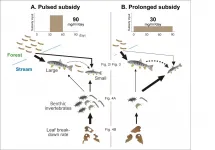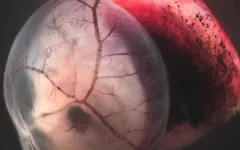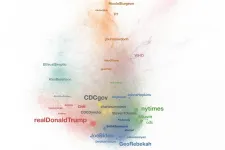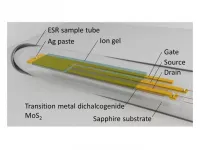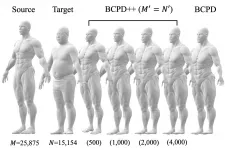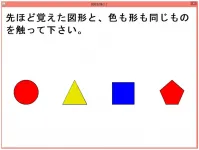These research results provide proof that changes in forest seasonality also affect the ecosystems of nearby rivers. This finding highlights the importance of predicting the effects of climate change on ecosystems.
The research group consisted of Associate Professor SATO Takuya and post-graduate student UEDA Rui of Kobe University's Graduate School of Science, and Associate Professor TAKIMOTO Gaku of The University of Tokyo's Graduate School of Agricultural and Life Sciences.
The results were published in the Journal of Animal Ecology on March 4, 2021.
Main Points
If terrestrial insects are only present in rivers for short, intensive periods, this reduces the competition for food between salmon. As a result, all of the salmon experience equal growth and little size variation is found between individuals. However if the same amount of terrestrial insects is available over an extended period, this results in a hierarchy where large salmon monopolize the food supply of terrestrial insects. As a result, only the large fish grow bigger and greater variation is found in the size of individual fish. Whether terrestrial insects are available for an intensive or prolonged period of time has a different effect on benthic invertebrate (*1) numbers and the leaf breakdown rate (*2). This result was only observed in the experimental groups where the majority of benthic invertebrates present were easy for the fish to consume. This study has illuminated that the length of seasonal cycles has a domino effect on ecosystems. Climate change is causing significant alterations in the seasonal cycles of living things. The results of this research indicate the importance of understanding and predicting the response of ecosystems to climate change. Research Background
Cold, clear flowing streams are home to many salmonid species including red-spotted masu salmon, cherry salmon and Japanese char (hereafter referred to as 'stream fish'). These stream fish prefer to eat the terrestrial invertebrates that fall into the river from the surrounding forests. When there are many of these land-dwelling insects in the water, the stream fish tend not to eat the benthic invertebrates that reside in the river, such as amphipods and the young of aquatic insects. This results in a sustained large population of benthic invertebrates, which eat the leaves that fall into the water. Consequently, this high population in turn accelerates the speed at which leaves in the river are decomposed (leaf breakdown rate = stream ecosystem functionality). Thus the presence of terrestrial invertebrates changes the diets of fish, which has a big impact (a positive indirect effect (*3)) on river food webs and ecosystem functions (Figure 1).
The amount of terrestrial invertebrates that end up in rivers increases as trees grow new leaves in spring, reaches a peak in early summer, and then decreases as the trees lose their leaves in fall. This seasonal pattern is common to streams located in cool temperate to temperate zones. However, the period between the growth of new leaves and defoliation is short in forests at high latitudes and elevations, but long in forests at low latitudes and elevations. Therefore, even though there may be a similar total number of terrestrial invertebrates in rivers over the course of a year, it is likely that they are present in the water for intensive periods at high latitudes/elevations and prolonged periods at low latitudes/elevations.
Research Aims
What kind of effect does the length of the terrestrial invertebrate supply period have on the food webs of streams and stream fish?
This research study investigated the impacts that different supply periods had on red-spotted masu salmon (Oncorhynchus masou ishikawae), as well as the impact on food webs and ecosystems in streams.
Research Methodology and Findings
Outdoor experiments were conducted in large pools that mimic river ecosystems at Kyoto University's Wakayama Research Forest Station. The experiments were carried out from August until November 2016, and exactly the same total amount and type of terrestrial invertebrates (mealworms) were supplied in each experiment during the 90-day period. In the pulsed experiment groups, concentrated amounts of mealworms were supplied every day during the 30-day period in the middle of the 90-day experiment (i.e., from the 30th to 60th days), whereas the prolonged experiment groups were given a steady supply of mealworms for a third of the 90-day period (Photos B and C). Control groups that were not given terrestrial invertebrates were also set up. The following aspects were investigated: salmonid fishes' stomach contents and body size, the number of benthic invertebrates, and the leaf breakdown rate.
In the pulsed groups, it was difficult for the bigger fish to monopolize the mealworm supply because a large amount was given at each time, therefore smaller fish were also able to eat mealworms (Figure 2A). After the experiment, it was found that there was little difference in size between fish in the pulsed groups (Figure 3), indicating that these conditions resulted in a community where it was difficult for individual fish to dominate the food supply. Conversely, in the prolonged groups, it was easy for larger fish to monopolize food flowing downstream, meaning that the out-competed smaller fish hardly ate any mealworms (Figure 2A). Post-experiment, a big variation in the size of fish was found in the prolonged group (Figure 3), revealing that these conditions had resulted in a community where large fish could easily monopolize the food supply. Furthermore, individuals that had reached a mature size were found among the dominant fish in the prolonged group, which is also indicative of the impact on population growth.
In the pulsed group where both large and small fish could eat mealworms, there was a significant decrease in the amount of benthic invertebrates eaten by all fish compared with the control group (Figure 2B). On the other hand, small fish had a tendency to frequently consume benthic invertebrates in the prolonged groups where large fish monopolized the mealworm supply (Figure 2B). Consequently, there was no significant decrease in the amount of consumed benthic invertebrates in the prolonged groups compared with the control.
Benthic invertebrate populations were at their highest in the pulsed groups where all salmon consumed fewer benthic invertebrates, resulting in the quickest breakdown of fallen leaves. On the other hand, in the prolonged groups where smaller fish ate many benthic invertebrates, the numbers of these insects and the leaf breakdown rate did not reach the levels seen in the pulsed groups. In other words, the presence of terrestrial invertebrates changed the feeding habits of the fish, which had a positive indirect effect on benthic invertebrates and the leaf breakdown rate, and this impact was greater in the pulsed groups than in the prolonged groups. Significant contrast was observed in the strength of this indirect effect between pulsed and prolonged groups when a large percentage of the benthic invertebrates consisted of midges, which are easy for salmon to consume. However, the effect was not observed when isopods, which are rarely found in the stomach contents of salmon, made up a large percentage of the benthic invertebrates.
The main cause behind this last finding is believed to be that it is difficult for the fishes' dietary habits to influence benthic invertebrate numbers and the leaf breakdown rate in such circumstances. If the majority of benthic invertebrates present are difficult for the fish to eat, then their diet is unlikely to change from terrestrial to benthic invertebrates.
Further Research
This research provides initial proof that the length of the period where forest-dwelling insects are present in rivers has an extensive impact on salmon growth rate and size distribution, stream food webs and ecosystem functions. In addition, the effect on stream ecosystems is more pronounced when there is a high population of benthic invertebrate species that are easy for salmon to consume. These results show the vital importance of studying organisms' seasonality, which connects ecosystems such as those of forests and rivers, in order to understand food web structures and ecosystem functions.
Based on these research results, we can see how worldwide climate change is impacting the seasonality of organisms living in specific ecosystems and that these changes in turn are likely to have a significant ripple effect on the surrounding ecosystems. Investigating these aspects, and being able to understand and predict the domino effect that climate change has on ecosystem behavior are important issues in the study of macrobiology.
At present, the researchers have set up observation sites all across Japan, from Hokkaido in the north to Kyushu in the south. They are conducting longitudinal observations on the seasonal rise and decline of forest and river-dwelling insects in collaboration with local researchers. Through a combination of wide-ranging, longitudinal species observations and outdoor experiments like the ones in this study, they hope to deepen our understanding of how climate change impacts ecosystems' seasonal aspects, with a view to being able to predict these effects.
INFORMATION:
Glossary
1. Benthic invertebrates: The collective name for aquatic, spineless organisms that live in the benthic zone, the ecological region at the lowest level of a body of water. In streams, this category includes the young of aquatic insects such as dragonflies and stoneflies, as well as amphipods and isopods.
2. Leaf breakdown rate: The speed at which leaves that fall into streams are broken down via being consumed by benthic invertebrates. This is an important ecosystem function for maintaining the matter cycle in streams.
3. Positive indirect effect: When terrestrial invertebrates are introduced to a stream, the main diet of the fish changes from benthic invertebrates to terrestrial, which results in an increase in both benthic invertebrate numbers and the breakdown rate of leaf detritus. The introduction of other organisms (the terrestrial invertebrates) changes the interaction between the two types of species (the predator-prey relationship between fish and benthic invertebrates).
Acknowledgments
This research was supported by a KAKENHI grant from the Japan Society for the Promotion of Science (JSPS, grant number JP 15H04422).
Journal Information
Title:
"The effects of resource subsidy duration in a detritus-based stream ecosystem: a mesocosm experiment"?
DOI: 10.1111/1365-2656.13440
Authors:
Takuya Sato, Rui Ueda and Gaku Takimoto
Journal:
Journal of Animal Ecology
